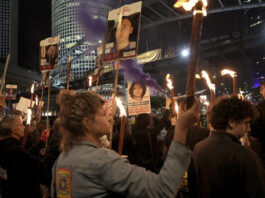UNITED NATIONS (AP) — At least one quarter of Gaza’s population – 576,000 people – are one step away from famine and virtually the entire population desperately needs food resulting in some aid trucks being shot at, looted and overwhelmed by hungry people, top U.N. officials said Tuesday.
The officials from the U.N. humanitarian office and the U.N.’s food and agriculture organizations painted a dire picture of all 2.3 million people in Gaza facing crisis levels of food insecurity or worse, and civil order breaking down especially in the north where food and other humanitarian supplies are scarce.
And as grim as the picture is today, U.N. humanitarian coordinator Ramesh Ramasingham told the U.N. Security Council that “there is every possibility for further deterioration.”
He said that in addition to a quarter of Gaza’s population close to famine, 1 in 6 children under the age of two in northern Gaza are suffering from “acute malnutrition and wasting,” where the body becomes emaciated.
Carl Skau, deputy executive director of the World Food Program, said that is “the worst level of child malnutrition anywhere in the world.” And he warned that “If nothing changes, a famine is imminent in northern Gaza” — the initial target of Israel’s military offensive following Hamas’ surprise attack in southern Israel on Oct. 7 that killed some 1,200 people and led to about 250 being taken captive.
In the latest example of the breakdown of civil order, Skau said WFP resumed deliveries to northern Gaza for the first time in three weeks on Feb. 18, and hoped to send 10 trucks a day for seven days to address immediate food needs and provide some reassurance to people that sufficient food would be arriving.
But on both Feb. 18 and Feb. 19, he said, WFP convoys faced delays at checkpoints, gunfire and other violence and the looting of food.
“At their destination, they were overwhelmed by desperately hungry people,” he said.
Skau said “the breakdown in civil order, driven by sheer desperation, is preventing the safe distribution of aid – and we have a duty to protect our staff.”
As a result, he said, WFP has suspended aid deliveries to the north until conditions are in place to ensure the security of its staff and the people receiving assistance.
Maurizio Martina, the Food and Agriculture Organization’s deputy director general, described the horrific state of farmland, greenhouses, bakeries and irrigation systems that are essential to produce, process and distribute food.
Since Oct. 9 – two days after the Hamas attacks – “the government of Israel’s reinforced blockade has included stopping or restricting food, electricity and fuel supplies, as well as commercial goods,” he said.
This has affected the entire food supply chain in different ways, Martina said.
As examples, he said, severe restrictions on fuel shipments are crippling water supplies and the functioning of desalination plants, with the water supply at only 7% of pre-October levels. Fuel shortages have also crippled the production and delivery of food and electricity, and seriously hampered the ability of bakeries to produce bread, he said.
Martina said the collapse of agricultural production in the north is already happening and in the most likely scenario will be complete by May. And as of Feb. 15, over 46% of all crop land in Gaza was assessed to be damaged, he said.
The FAO official presented more alarming figures from Israel’s offensive — a high number of animal shelters and sheep and dairy farms destroyed, over one-quarter of water wells destroyed, and 339 hectares of greenhouses destroyed. And he said the war has also heavily impacted the harvest of olives and citrus fruits, a key Palestinian money earner.
As for animals, Martina said, many livestock owners report substantial losses, all poultry have likely been slaughtered, and as many as 65% of calves and 70% of beef cattle are assumed to have died.
Israel’s deputy U.N. ambassador Brett Miller told the council that while fighting Hamas it is doing “all it can to care for civilians,” and is working constantly to ensure the entry of humanitarian aid from numerous countries and U.N. agencies.
Since the Oct. 7 attacks, he said, Israel has facilitated the delivery of 254,000 tons of humanitarian aid including 165,000 tons of food. “There is absolutely no limit – and I repeat there is no limit – to the amount of humanitarian aid that can be sent to the civilian population of Gaza,” he said.
Miller countered that 20 bakeries throughout Gaza are producing over 2 million pita breads a day.
He accused the U.N. of refusing to deliver aid to northern Gaza, and some U.N. officials of trying to shift the blame to Israel.
In recent days, Miller said, 508 trucks have been waiting to cross into Gaza with Israeli approval. “So where is the U.N. and its aid agencies? How can it be that Israel is libelously held responsible for a situation that is clearly the U.N.’s fault?” he asked.
U.N. humanitarian coordinator Ramasingham, WFP’s Skau and FAO’s Martina all had a similar response: The first step to eliminating the looming threat of famine is a ceasefire so humanitarian workers can enter Gaza.
“If nothing is done, we fear widespread famine in Gaza is almost inevitable,” Ramasingham said, and the Palestinian death toll which has reached almost 30,000 “will have many more victims.” That figure from the Gaza Health Ministry doesn’t distinguish between civilians and combatants, though the U.N. says the majority are women and children.
This website uses cookies so that we can provide you with the best user experience possible. Cookie information is stored in your browser and performs functions such as recognising you when you return to our website and helping our team to understand which sections of the website you find most interesting and useful.
